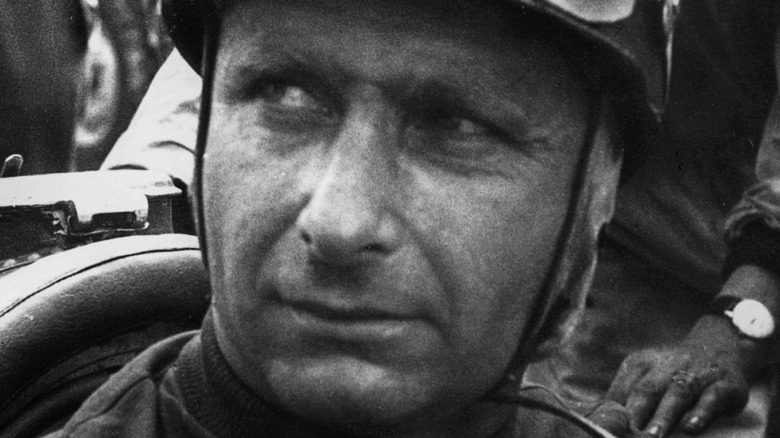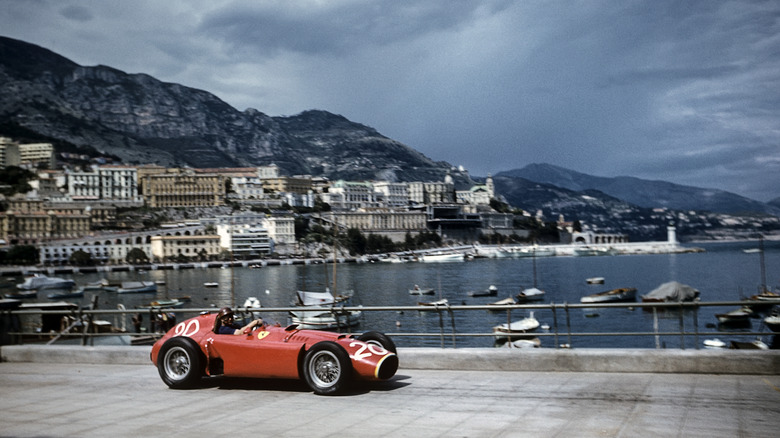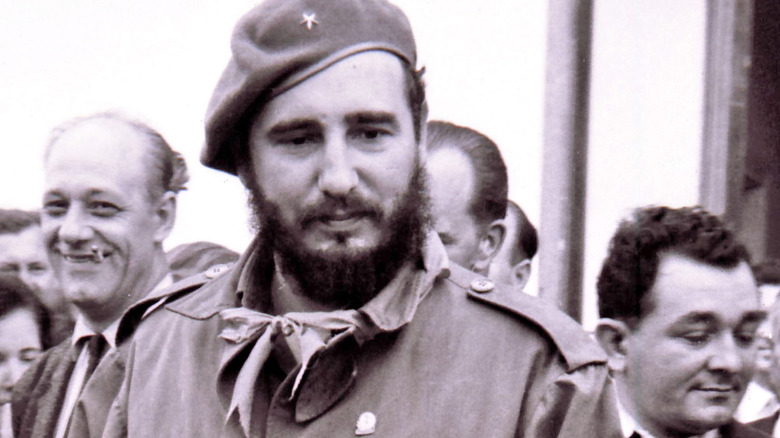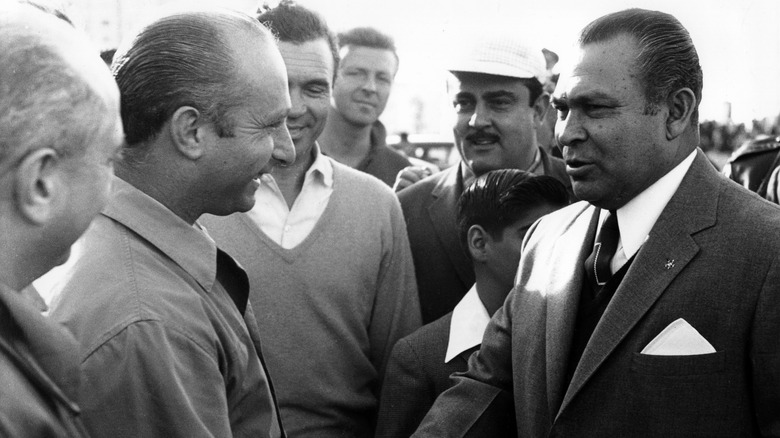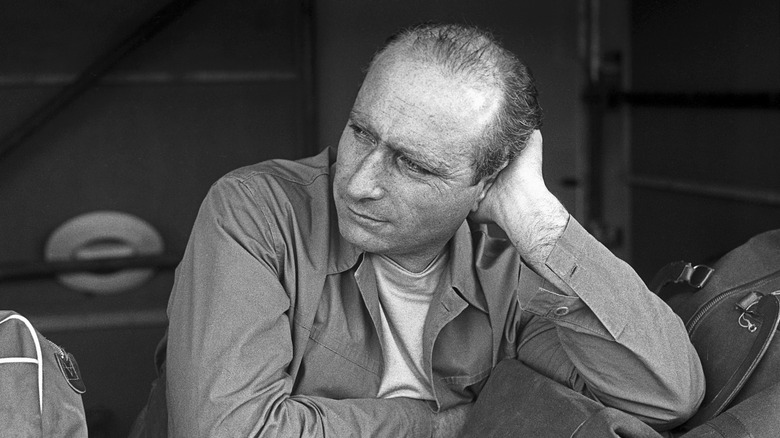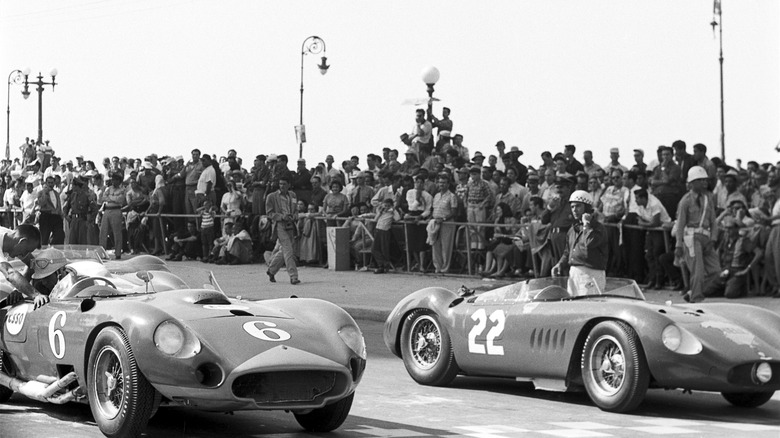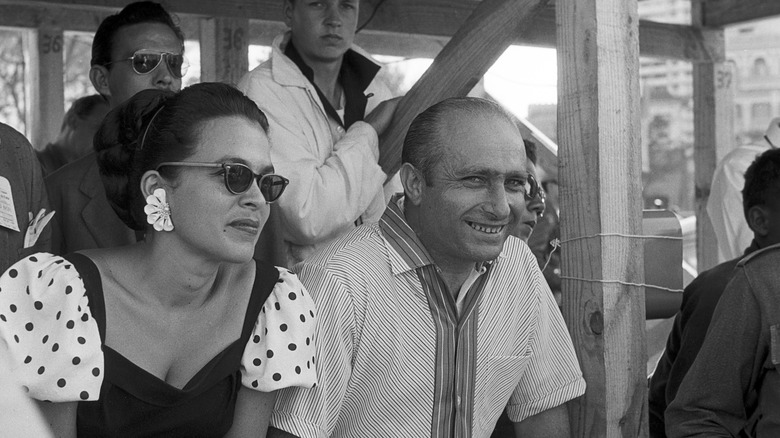How A Formula 1 Champion Wound Up Getting Kidnapped
Hosting a major international sporting event is a great way for a country to put itself in front of a global audience and showcase everything it has to offer. Unfortunately, this method has also been used to draw attention away from human rights violations and other less than admirable things going on within the nation's borders — a political sleight of hand trick now known as sportswashing. It's a new term, but not a new practice — Germany hosted the 1936 Olympics in hopes of showing off the might of the Third Reich. In recent years, sportswashing has become increasingly prevalent with the 2022 Beijing Winter Olympics, the 2022 FIFA World Cup, and the Formula 1 Saudia Arabian Grand Prix, per The Guardian.
Speaking of Formula 1, another attempt to showcase a country — this time one in a state of political turmoil — came via the Cuban Grand Prix. According to Vintage Road & Racecar, Cuba had started to undergo a seismic shift when its formerly democratic government was overthrown by President Fulgencio Batista in 1952. This led to an almost decade-long power struggle that came to an end in 1960 when communist dictator Fidel Castro gained control.
In the meantime, Cuba wanted to show the world that it was open for business, so it held a series of races between 1957 and 1960, with the most notable edition being the one in 1958. It was a disastrous event that included a crash that killed multiple spectators and the shocking kidnapping of five-time Formula 1 world champion Juan Manuel Fangio.
Juan Manuel Fangio: F1's first legend
Before there was Lewis Hamilton, before there was Michaell Schumacher, there was Juan Manuel Fangio. Fangio was born in 1911 into a family of Italian immigrants who settled in the remote town of Balcarce, Argentina. Even at a young age, Fangio had an immense interest in cars. According to Formula 1, he started working as a mechanic when he was still a kid and continued to through most of his life.
Fangio's racing career started with running cars that he prepared himself in grueling long-distance races through South America. These races could sometimes last for weeks and spanned thousands of miles, but Fangio demonstrated many of the same traits that made him a legend when he made the jump to Grand Prix racing. He was in his late 30s when he made his first start in Europe — significantly older than most competitors — but his experience and mechanical expertise paid dividends.
Fangio entered the inaugural Formula 1 World Championship in 1950, driving for Alfa Romeo. According to the Motor Sports Hall of Fame, he finished in second place in the championship standings, but he took top honors in 1951. It was the first of five championships that Fangio won over his career, the last of which he won in 1957. His success made him a massively popular figure in both Argentina and Italy, and his record of five career world championships stood until 2003 when it was broken by Michael Schumacher.
A power struggle in Cuba
While Juan Manuel Fangio was tearing up Grand Prix circuits around the world, there was an intense struggle for control over Cuba, the island nation which at its closest point sits less than 100 miles from the United States, per the Lincoln Journal Star. According to Britannica, Cuba gained independence from Spain in the late stages of the 19th century, but when Fulgencio Batista took over, things started to change. Havana came under the control of organized crime, with mobster Meyer Lansky leading the charge in building up the Sin City-like reputation for gambling, booze, prostitution, and cigars.
Cuba became a hotspot for tourists looking to throw some money around, including movie stars, high-powered businessmen, and high-powered businessmen whose line of work toed the line of legality (read: gangsters). In the mountainous regions, beard-sporting rebel groups began to take shape, one of which was led by Fidel Castro and his brother, Raul. They launched their first assault on the government in 1953, which set the wheels in motion for the Castros' 26th of July Movement and its nearly-decade long bout with Batista's government.
According to Britannica, after being arrested and spending time in Mexico, a reorganized Castro stormed Cuba, waging guerilla warfare and starting propaganda campaigns. Despite the mounting issues with rebels, President Batista, perhaps wanting to show that everything was fine in Cuba and that there was no reason for alarm, decided to bring a Formula 1 Grand Prix to the country.
The 1958 Cuban Grand Prix
The first Cuban Grand Prix was held in 1957, and according to Racing Sports Cars, the race went the full distance and was otherwise uneventful. Juan Manuel Fangio came in first place behind the wheel of his Maserati, with American Caroll Shelby's Ferrari in second about 1 minute and 20 seconds behind. Things went off without a hitch. To put it mildly, this was not the case in 1958. The first sign of trouble was when Swedish driver Jo Bonnier and two of his friends were arrested and suspected of being Cuban rebels. The reason was that no one in Cuba sported a beard except for rebels like Fidel Castro. Unfortunately, Bonnier and his pals had beards, but, of course, they weren't rebels (via Vintage Road & Racecar).
With five championships to his name and after having won the last time F1 stopped in Cuba, Fangio was the highest-profile name on the entry list. In the practice and qualifying sessions leading up to the Grand Prix, it looked as if the lightning-quick Argentine would be the man to be once again. Driver Bruce Kessler told Vintage Road & Racecar that that weekend, Fangio "would pass me like I was standing still. He threw that big car around like a go-kart. It was something to watch." Flowers courtesy of adoring fans even rained down on Fangio from Havana balconies. Unfortunately, they wouldn't get to see him even get to the starting grid.
The kidnapping of Juan Manuel Fangio
The words, "In the name of the 26th of July Movement, follow me," and a .45 caliber revolver pointed at him would've been the first indications to Juan Manuel Fangio that his chances of back-to-back Cuban Grand Prix victories were slim (via Vintage Road & Racecar). Fangio had been in his hotel's lobby when one man donning the trademark beard of the Cuban rebels — later identified as Manuel Uziel — escorted the legendary driver outside, where a car and a quartet of heavily armed rebels were waiting.
Fangio had been kidnapped in hopes that it would cast President Batista in a negative light and influence the international perception of his regime, and by proxy, show the world what Castro and his movement were doing. It's believed that Fangio hadn't been the rebel's only target and that they had intended on kidnapping British driver Stirling Moss, but Fangio was able to convince them not to. The rebels told Fangio that he would be released after the Grand Prix, and fortunately, Fangio later reported that he was treated well while in captivity.
Tragedy strikes the Cuban Grand Prix
Juan Manuel Fangio's kidnapping wasn't enough to forego the Grand Prix, though, in retrospect, it would've been better if it had. The race instead went on as planned, but with each driver assigned a bodyguard, per Vintage Road & Racecar. All the drivers even declined an invitation to have breakfast at Fulgencio Batista's palace out of fear that another one of them would be kidnapped. The race drew a massive crowd — an estimated 200,000 people showed up to see the race, which was scheduled to start at 2 p.m. but was met with a series of delays. Cars overheated on the grid and caused one delay, while another one was because murmurs were going around that the rebels had released Fangio and that he was on his way to the race. He wasn't.
The race got started about half an hour later than scheduled, and it lasted a total of six laps around the 5.59 kilometer (just under 3.5 miles) circuit, per Racing Sports Cars. Cuban driver Armando Garcia Cifuentes hit a patch of oil and lost control of his Ferrari 500 TR, which careened into the crowd. Tragically, as many as seven people were killed, and dozens more were injured in the incident. According to History, there were initial fears that the oil slick that caused Ciguentes' crash was an act of sabotage perpetrated by Castro's rebels, though it's now believed that it was the result of a broken oil line from Argentinian Roberto Mières Porsche.
The aftermath
After their nightmare trip to Cuba in 1958, the Formula 1 circus decided to keep its distance from the island the following year. However, they didn't give up hope that they could establish an annual Grand Prix in Cuba and returned in 1960, where Stirling Moss drove to the top step of the podium in his Maserati Tipo 61 (via Driver Database). By that point, Castro had taken over Cuba, and Formula 1 opted not to return to the island — and hasn't since.
Juan Manuel Fangio retired after the 1958 Formula 1 season, citing the fact that cars were starting to get too fast and the danger was getting too high, per History. He claimed that he survived a lengthy racing career without seatbelts and fire retardant clothing as proof of his driving acumen, and you'd be hard-pressed to find anyone willing to argue that point. While Fangio may have expected to face the dangers of high speeds, fires, and flying shrapnel that every racing driver of that era accounted for, its safe to say that one danger he likely never considered was facing the business end of a revolver and being used as a bargaining chip during the Cuban Revolution.
